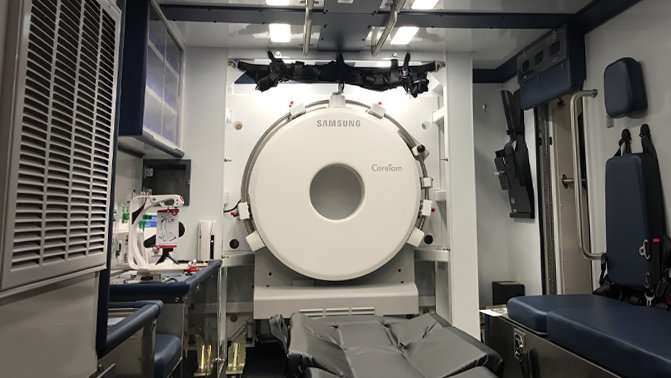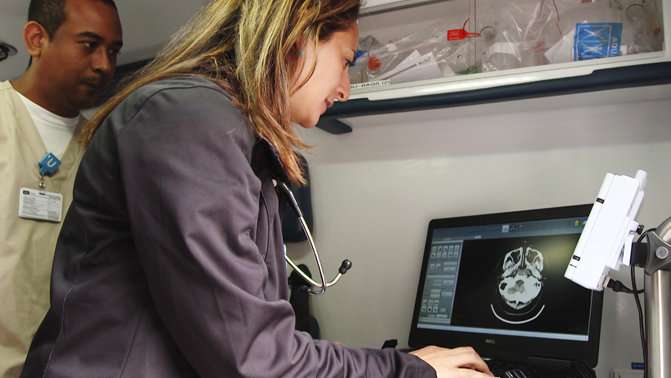Mobile stroke units designed to quickly reach, treat patients

"Time is brain." That's the mantra of physicians who warn that those with stroke symptoms need immediate medical attention.
The sooner a stroke is treated, the greater the possibility of saving brain cells and achieving recovery.
Now, about a dozen hospitals nationwide are evaluating and treating patients faster with mobile stroke units. These special ambulances are equipped with a CT scanner, an imaging technician, a paramedic, a nurse, a neurologist or telemedicine connection to a neurologist, and the clot-busting medicine tissue plasminogen activator, known as tPA.
In an ischemic stroke—the most common type, caused by a clot blocking blood flow to the brain—tPA can improve recovery chances if administered within three hours, or up to 4 ½ hours for some patients.
"Time is so critical," said James Grotta, M.D., director of stroke research in the Clinical Innovation and Research Institute at Memorial Hermann-Texas Medical Center in Houston, where the first mobile stroke unit was launched in the United States in 2014.
"It gets it all moving faster," Grotta said. "The idea is to get more treated in that first hour."
The concept began in Germany, where Grotta visited in 2012 to learn about that country's mobile stroke response. Then he oversaw the start of the mobile stroke unit in Houston.
When stroke is suspected based on a 911 call, the mobile unit is dispatched within a 7- or 8-mile radius, allowing evaluation of the patient at the scene. Or, the mobile unit may meet a patient halfway after transport in a regular ambulance.
In some cases, the patient may start feeling better and it's determined a stroke isn't occurring, or medical officials may suspect a hemorrhagic stroke, a less common type that occurs when a vessel ruptures and bleeds into the brain.
For those diagnosed with an ischemic stroke, tPA treatment can commence. Another advantage is quicker triage for patients needing a procedure to remove the clot using a stent retriever, Grotta noted.
Approximately one-third of stroke patients reached by a mobile stroke unit get treated in the first hour after stroke symptoms start, compared with less than 1 percent who are treated at the emergency room, Grotta said.

"It starts with the patient calling 911," he said. "Recognizing, and not ignoring, the symptoms of a stroke is critical."
Symptoms can include face drooping, arm weakness and speech difficulty. Approximately 800,000 Americans each year have a stroke, the nation's fifth-leading cause of death.
The University of California, Los Angeles launched a mobile unit in September after working closely with local government officials to address regulatory issues, said May Nour, M.D., Ph.D., an interventional neurologist and medical director of the UCLA Arline and Henry Gluck Stroke Rescue Program.
Although the benefits and cost-effectiveness must be scientifically proven before there is wider use, Nour hopes to soon have enough mobile units to cover all of Los Angeles County.
"Anything that's new takes time," she said. "We are doing the tough task of banding together nationally and internationally to evaluate the evidence."
A study in The Lancet Neurology in September 2016 did not find statistically better outcomes in pre-hospital treatment versus conventional treatment. But the study, limited by a small number of patients, suggested mobile unit treatment might lead to improved results. Researchers said a large-scale trial is needed.
Grotta's team is conducting a large randomized trial through PCORI, the Patient-Centered Outcomes Research Institute. Along with Houston, mobile stroke units in Memphis, Tennessee, and Denver, Colorado, are participating to examine patient outcomes during weeks when a mobile unit is dispatched versus other weeks of standard treatment. A separate analysis will look at the costs of implementing a mobile stroke unit versus the cost savings that result from better outcomes for patients.
The price for a mobile stroke unit ranges from $600,000 to $2 million, according to the consortium PRESTO, the PRE-hospital Stroke Treatment Organization. Making a physician available through telemedicine rather than in person can save money in staffing and has been determined to be just as accurate, Grotta said.
Hospitals usually pay for the units through philanthropy because insurance reimbursements don't cover the startup costs and cover little of the clinical activities performed in the unit, he said, but more research may show clear cost benefits.
Nour believes cost-effectiveness ultimately will be proven with the positive impact on patients' lives.
"Proving cost-effectiveness will allow this innovative stroke care delivery platform to be accessible to all stroke survivors by changing the infrastructure of prehospital care," she said. "But we need to show that."
More information: Alexander Kunz et al. Functional outcomes of pre-hospital thrombolysis in a mobile stroke treatment unit compared with conventional care: an observational registry study, The Lancet Neurology (2016). DOI: 10.1016/S1474-4422(16)30129-6















